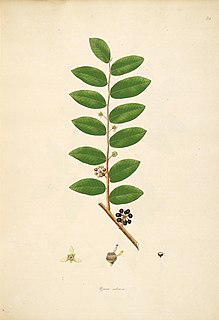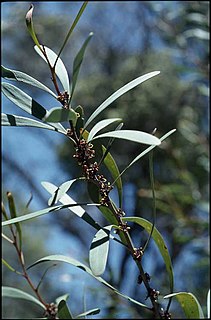
Nepenthes × hookeriana, or Hooker's Pitcher-Plant, is a common natural hybrid involving N. ampullaria and N. rafflesiana. It was originally described as a species.

Banksia prionotes, commonly known as acorn banksia or orange banksia, is a species of shrub or tree of the genus Banksia in the family Proteaceae. It is native to the southwest of Western Australia and can reach up to 10 m (33 ft) in height. It can be much smaller in more exposed areas or in the north of its range. This species has serrated, dull green leaves and large, bright flower spikes, initially white before opening to a bright orange. Its common name arises from the partly opened inflorescence, which is shaped like an acorn. The tree is a popular garden plant and also of importance to the cut flower industry.

Banksia hookeriana, commonly known as Hooker's banksia, is a species of shrub of the genus Banksia in the family Proteaceae. It is native to the southwest of Western Australia and can reach up to 4 m (13 ft) high and 3 m (9.8 ft) wide. This species has long narrow serrated leaves and large, bright flower spikes, initially white before opening to a bright orange that appear over the cooler months. The flowers are pollinated by honeyeaters. The ageing flower spikes develop woody seed pods known as follicles. B. hookeriana is serotinous — large numbers of seeds are stored in the plant canopy for years until the plants are burnt by bushfire.

Polyalthia malabarica is a species of plant in the family Annonaceae and tribe Miliuseae. It is endemic to south-west India. It is threatened by habitat loss.

Polyalthia is a genus of flowering plants in the family Annonaceae. There are approximately 90 species distributed from Africa to Asia and the Pacific.
Phaeanthus ophthalmicus is a species of plant in the family Annonaceae and tribe Miliuseae. It is a tree found in Peninsular Malaysia and Singapore.
Polyalthia pachyphylla is a species of plant in the family Annonaceae. It is a tree endemic to Peninsular Malaysia.
Polyalthia palawanensis is a species of plant in the Annonaceae family. It is endemic to the Philippines.
Disepalum plagioneurum is a species of plant in the Annonaceae family. It is found in China and northern Viet Nam.
Polyalthia rufescens is a species of plant in the Annonaceae family. It is native to Kerala and Tamil Nadu in India. It is threatened by habitat loss.
Polyalthia shendurunii is a species of plant in the Annonaceae family. It is endemic to Kerala in India.
Polyalthia verrucipes is a species of plant in the Annonaceae family. It is endemic to China.
In biodiversity informatics, a chresonym is the cited use of a taxon name, usually a species name, within a publication. The term is derived from the Greek χρῆσις chresis meaning "a use" and refers to published usage of a name.

Grevillea hookeriana is a shrub species in the family Proteaceae. It is endemic to the south west region of Western Australia.

Papilionanthe Miss Joaquim, also known as Vanda Miss Joaquim, the Singapore orchid, or the Princess Aloha orchid, is a hybrid orchid that is the national flower of Singapore. For its resilience and year-round blooming quality, it was chosen on 15 April 1981 to represent Singapore's uniqueness and hybrid culture.

Salix hookeriana is a species of willow known by the common names dune willow, coastal willow, and Hooker's willow.

Plantago hookeriana, commonly called Hookers plantain, is a species of flowering plant in the plantain family (Plantaginaceae). It is native to Texas and Louisiana in the United States. It is typically found in disturbed sandy areas.

Huberantha cerasoides is a species of trees in the family Annonaceae and tribe Miliuseae. It is the type species of the relatively new genus Huberantha.

Iris hookeriana is a plant species in the genus Iris, it is also in the subgenus Iris and in the section Pseudoregelia. It is a rhizomatous perennial, from the Himalayan mountains of India and Pakistan. It has long pale green or yellow green leaves, long slender stem and fragrant blue, purple or lilac flowers, that are mottled with a darker colour. It is cultivated as an ornamental plant in temperate regions.

Hakea hookeriana, commonly known as the Barren Range hakea, is a shrub of the genus Hakea native to Western Australia.












